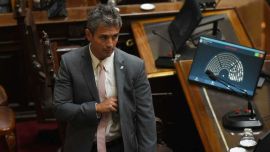Fernando Krakowiak, a journalist and educator with EcoJournal, describes the government's plan as "tariff segmentation" with "three clear groups: people with low, medium and high incomes."
The analyst said in a radio interview with Net TV and Radio Perfil (FM 101.9) that the plans would kick in quicker than anticipated and highlighted that middle-income users would have a subsidised ceiling on their consumption.
“What the government announced was the implementation of the decree that [former Economy Minister Martín] Guzmán had promoted on tariff segmentation, in which three groups are distinguished: people with low, medium and high incomes,” said the journalist.
“The problem is that when the government implemented the regulation it said that 10 percent of households were going to lose their subsidies, but according to the data that we have now and that [Economy Minister Sergio] Massa had implied, we are talking about 30 percent of households in a period of six months,” he added
“This means that in the case of electricity there will be an increase of around 200 percent and in the case of gas, an increase of around 90 percent. The 30 percent is approximate because the register is still open and because the government maintains that, in the case of electricity, there are 13 million households, but the association of electricity distributors itself says there are 15.5 million. If this is true and only nine million have signed up, we are talking about more than 30 percent of the subsidy being left out,” said Krakowiak.
“The novelty introduced by Massa is that middle-income sectors have a subsidised ceiling on their consumption: 400 kilowatt hours per month for electricity, which is quite generous considering that the distributors measure it by two months.
“And the government itself reported that approximately 80 percent consume less than 400 kilowatt hours per month, meaning that within the middle sectors 80 percent would remain unchanged and 20 percent will partially lose the subsidy, what they consume above 400 kilowatt hours will pay the full rate, only the differential above the cap.
“In the case of gas, it is more complex: the aim is to subsidise 70 percent of the average for each category of user … to explain this scheme to the people how much they are going to pay, you have to be a magician, not even the government could explain it,” he said.
– TIMES/PERFIL






















Comments